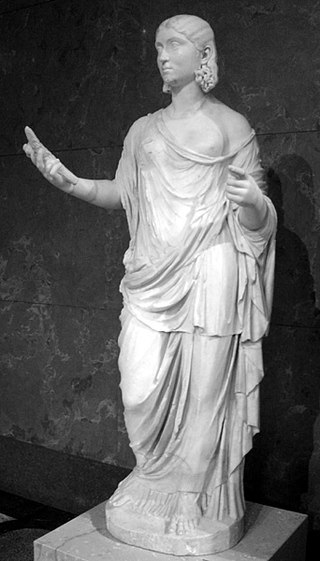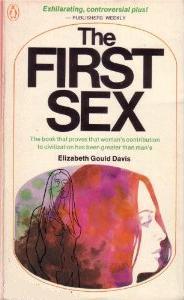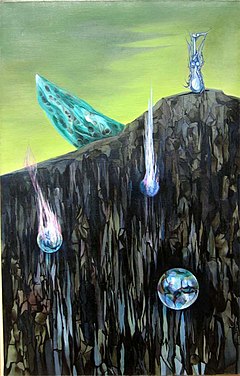Feminist theology is a movement found in several religions, including Buddhism, Hinduism, Sikhism, Neopaganism, Baháʼí Faith, Judaism, Islam, Christianity and New Thought, to reconsider the traditions, practices, scriptures, and theologies of those religions from a feminist perspective. Some of the goals of feminist theology include increasing the role of women among clergy and religious authorities, reinterpreting patriarchal (male-dominated) imagery and language about God, determining women's place in relation to career and motherhood, studying images of women in the religions' sacred texts, and matriarchal religion.

Thealogy views divine matters through feminine perspectives including but not limited to feminism. Valerie Saiving, Isaac Bonewits (1976) and Naomi Goldenberg (1979) introduced the concept as a neologism. Its use then widened to mean all feminine ideas of the sacred, which Charlotte Caron usefully explained in 1993: "reflection on the divine in feminine or feminist terms". By 1996, when Melissa Raphael published Thealogy and Embodiment, the term was well established.

Matriarchy is a social system in which positions of dominance and authority are primarily held by women. In a broader sense it can also extend to moral authority, social privilege, and control of property. While those definitions apply in general English, definitions specific to anthropology and feminism differ in some respects. Most anthropologists hold that there are no known societies that are unambiguously matriarchal.
Matrilineality is the tracing of kinship through the female line. It may also correlate with a social system in which each person is identified with their matriline, their mother's lineage, and which can involve the inheritance of property and titles. A matriline is a line of descent from a female ancestor to a descendant of either gender in which the individuals in all intervening generations are mothers. In a matrilineal descent system, an individual is considered to belong to the same descent group as their mother. This ancient matrilineal descent pattern is in contrast to the currently more popular pattern of patrilineal descent from which a family name is usually derived. The matriline of historical nobility was also called their enatic or uterine ancestry, corresponding to the patrilineal or "agnatic" ancestry.

When God Was a Woman is the U.S. title of a 1976 book by sculptor and art historian Merlin Stone. It was published earlier in the United Kingdom as The Paradise Papers: The Suppression of Women's Rites. It has been translated into French as Quand Dieu était femme in 1978, into Dutch as Eens was God als Vrouw belichaamd – De onderdrukking van de riten van de vrouw in 1979, into German as Als Gott eine Frau war in 1989 and into Italian as Quando Dio era una donna in 2011.

A mother goddess is a major goddess characterized as a mother or progenitor, either as an embodiment of motherhood and fertility or fulfilling the cosmological role of a creator- and/or destroyer-figure, typically associated the Earth, sky, and/or the life-giving bounties thereof in a maternal relation with humanity or other gods. When equated in this lattermost function with the earth or the natural world, such goddesses are sometimes referred to as the Mother Earth or Earth Mother, deity in various animistic or pantheistic religions. The earth goddess is archetypally the wife or feminine counterpart of the Sky Father or Father Heaven, particularly in theologies derived from the Proto-Indo-European sphere. In some polytheistic cultures, such as the Ancient Egyptian religion which narrates the cosmic egg myth, the sky is instead seen as the Heavenly Mother or Sky Mother as in Nut and Hathor, and the earth god is regarded as the male, paternal, and terrestrial partner, as in Osiris or Geb who hatched out of the maternal cosmic egg.
The Triple Goddess is a deity or deity archetype revered in many Neopagan religious and spiritual traditions. In common Neopagan usage, the Triple Goddess is viewed as a triunity of three distinct aspects or figures united in one being. These three figures are often described as the Maiden, the Mother, and the Crone, each of which symbolizes both a separate stage in the female life cycle and a phase of the Moon, and often rules one of the realms of heavens, earth, and underworld. In various forms of Wicca, her masculine consort is the Horned God.
This is an index of articles related to the issue of feminism, women's liberation, the women's movement, and women's rights.

Johann Jakob Bachofen was a Swiss antiquarian, jurist, philologist, anthropologist, and professor of Roman law at the University of Basel from 1841 to 1844.

The Goddess movement is a revivalistic Neopagan religious movement which includes spiritual beliefs and practices that emerged predominantly in the Western world during the 1970s. The movement grew as a reaction both against Abrahamic religions, which exclusively have gods with whom are referred by masculine grammatical articles and pronouns, and secularism. It revolves around Goddess worship and the veneration for the divine feminine, and may include a focus on women or on one or more understandings of gender or femininity.

The First Sex is a 1971 book by the American librarian Elizabeth Gould Davis, considered part of the second wave of feminism. In the book, Gould Davis aimed to show that early human society consisted of matriarchal "queendoms" based around worship of the "Great Goddess", and characterised by pacifism and democracy. Gould Davis argued that the early matriarchal societies attained a high level of civilization, which was largely wiped out as a result of the "patriarchal revolution". She asserted that patriarchy introduced a new system of society, based on property rights rather than human rights, and worshipping a stern and vengeful male deity instead of the caring and nurturing Mother Goddess.
Cultural transformation theory proposes that societies used to follow a “partnership model” of civilization but over time, it gave way to today's current “dominator model” of civilization. This theory was first proposed by Riane Eisler, a cultural scholar, in her book The Chalice and the Blade. Eisler affirms that societies exist on a partnership-domination continuum but we as a species have moved away from our former partnership orientation to a more domination orientation by uplifting masculine ideals over feminine ideals. She insists that people do not have to live in a society based on the rule of one gender class over the other. There is historical evidence that another type of society, where all individuals are equal, is possible.

Woman's Evolution: From Matriarchal Clan to Patriarchal Family is a 1975 book by the American revolutionary socialist Evelyn Reed. The book gives a Marxist view on the history of women and is considered to be a pioneer work of Marxist feminism. It has been translated into many languages.

Goddess Remembered is a 1989 Canadian documentary on the Goddess movement and feminist theories surrounding Goddess worship in Old European culture according to Marija Gimbutas, and Merlin Stone's 1976 book When God Was a Woman.

The Myth of Matriarchal Prehistory: Why An Invented Past Will Not Give Women a Future is a 2000 book by Cynthia Eller that seeks to deconstruct the theory of a prehistoric matriarchy. This hypothesis, she says, developed in 19th century scholarship and was taken up by 1970s second-wave feminism following Marija Gimbutas. Eller, a retired professor of religious studies at Claremont Graduate University, argues in the book that this theory is mistaken and its continued defence is harmful to the feminist agenda.

The Great Mother: An Analysis of the Archetype is a book discussing mother goddesses by the psychologist Erich Neumann. The dedication reads, "To C. G. Jung friend and master in his eightieth year". Although Neumann completed the German manuscript in Israel in 1951, The Great Mother was first published in English in 1955. The work has been seen as an enduring contribution to the literature inspired by Jung, and was the first to analyze an archetype with such depth and scope.

The Chalice and The Blade: Our History, Our Future is a 1987 book by Riane Eisler. The author presents a conceptual framework for studying social systems with particular attention to how a society constructs roles and relations between the female and male halves of humanity.
Naomi Ruth Goldenberg is a professor at the University of Ottawa. Her regular undergraduate courses include Gender and Religion, Women and Religions, Psychology of Religion and Method and Theory in the Study of Religion. Goldenberg is best known for her work in the areas of Feminist Theory and Religion, Gender and Religion, as well as the Psychoanalytic Theory and Political Theory of Religion. She is one of the early members of the Women's Caucus at the American Academy of Religion and Society of Biblical Literature and continues to work on and support scholarship in areas of religion and feminism, psychoanalytic theory, women's issues, gender. Currently, Goldenberg is writing about understanding religions as vestigial states. Her theory demystifies religion in order to continue the feminist critique she articulated in her earlier work.

William Bond was born in London, England in 1946. When he was four years old, his parents immigrated to Australia and lived in the state of Western Australia. In 1970, he returned to England, and has lived there ever since.

A large amount of research on prehistory has been dedicated to the role of women in pre-literary society. Tasks typically undertaken by women are thought to have formed a major sexual division of labor in relation to child-rearing, gathering, and other everyday occupations. More recent research has however suggested women also played an active role in hunting and other physical activities in place of the exclusively domestic roles traditionally occupied by women in literary civilizations.

















